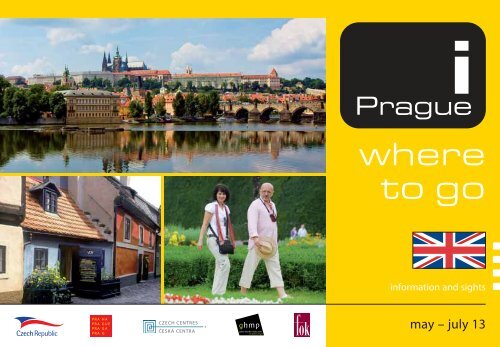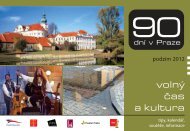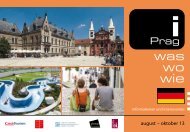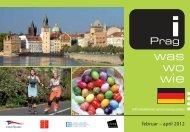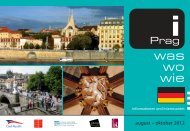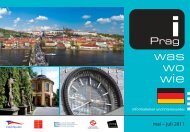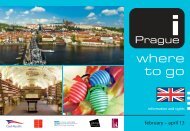where to go - i-Prague
where to go - i-Prague
where to go - i-Prague
Create successful ePaper yourself
Turn your PDF publications into a flip-book with our unique Google optimized e-Paper software.
i<br />
<strong>Prague</strong><br />
<strong>where</strong><br />
<strong>to</strong> <strong>go</strong><br />
information and sights<br />
may – july 13
i<br />
<strong>Prague</strong><br />
PRAGUE<br />
PALLADIUM<br />
ULTIMATE DOWNTOWN<br />
SHOPPING MALL<br />
200 shops<br />
& restaurants<br />
open 7 days a week<br />
Currently...<br />
Rollando Villazón • The Mexican tenor and opera megastar pays homage <strong>to</strong> Giuseppe Verdi,<br />
one of the greatest opera composers of all time. Smetana Hall, Municipal House • 8 May www . nachtigallartists.cz<br />
Exhibition of The Crown Jewels • The Crown Jewels are displayed in Vladislav Hall in <strong>Prague</strong> Castle.<br />
They are permanently safely kept in <strong>Prague</strong> Castle and may be displayed only on quite<br />
exceptional occasions. • 10 – 19 May<br />
Fairy-tale landscapes from succulent plants • An outdoor exhibition displaying s<strong>to</strong>ne bowls<br />
and rockworks adorned with various types of succulent plants. Botanical Gardens • 10 – 26 May<br />
www . hrad.cz<br />
www . sukulent.cz<br />
<strong>Prague</strong> Spring • The 68th edition of the international music festival, traditionally featuring celebrated<br />
musicians and orchestras from all over the world. Various venues in <strong>Prague</strong> • 12 May – 2 June www . festival.cz<br />
Czech Beer Festival • Various delicacies from Czech breweries, butchers, cooks and bakers.<br />
Exhibition Grounds, Holešovice • 16 May – 1 June<br />
www . ceskypivnifestival.cz<br />
Náměstí Republiky<br />
Joe Cocker • The British singer will be presenting in <strong>Prague</strong> his new album Fire It Up.<br />
O2 Arena • 19 May<br />
www . o2arena.cz<br />
PALLADIUM<br />
PARKING<br />
NONSTOP<br />
900 underground parking spaces<br />
Access 24 hours a day, 7 days a week<br />
Safe parking in the center of <strong>Prague</strong><br />
Convenient long-term parking rates<br />
50°5’23.000”N, 14°25’40.600”E<br />
<strong>Prague</strong> 1, Revoluční 1<br />
www.palladiumpraha.cz<br />
ČSOB pojišťovna <strong>Prague</strong> Boat Race • The traditional regatta taking place under<br />
the auspices of the Mayor of <strong>Prague</strong>. The river Vltava, <strong>Prague</strong> • 7 – 9 June<br />
www . prima<strong>to</strong>rky.cz<br />
Ivan Lendl: Alfons Mucha • The world premiere of the exhibition of 116 posters by the famous<br />
Czech Art Nouveau painter from the tennis star’s collection. Municipal House • Until 31 July www . lendl-mucha.cz<br />
Respect Festival • The 16th edition of the annual international world-music festival with<br />
the longest tradition in the Czech Republic. Štvanice island • 15 – 16 June<br />
Goldilocks • A dance fairy-tale performance for children and adults alike, choreographed<br />
by Jan Kodet <strong>to</strong> music by Vladimír Franz. Estates Theatre • 15 June<br />
United Islands • The 10th edition of the annual international music festival<br />
taking place on Vltava islands and river banks. Various places in <strong>Prague</strong> • 20 – 22 June<br />
www . respectmusic.cz<br />
www . narodni-divadlo.cz<br />
www . unitedislands.cz<br />
Bohemia Jazz Fest 2013 • One of the largest summer open-air jazz festivals in Europe.<br />
Old Town Square • 10 – 11 July<br />
www . bohemiajazzfestival.cz<br />
Jan Zrzavý – The Venetian Bagatelles • A remarkable exhibition of 24 minor works created<br />
by the Czech painter Jan Zrzavý in the 1960s and 1970s during his stays at the Il Reden<strong>to</strong>re Capuchin<br />
monastery on the Venetian island of Guidecca. Loretta, <strong>Prague</strong> Castle District • 7 May – 30 September www . loreta.cz
Did you know that...<br />
◗ ... the Dancing House on <strong>Prague</strong>’s Jiráskovo Square,<br />
which attracts the attention of architects and lay admirers<br />
of modern buildings, was also called<br />
the Fred and Ginger building due <strong>to</strong> the shape of its<br />
corner <strong>to</strong>wers? The Dancing House was one of the<br />
first daring modern buildings <strong>to</strong> be built in <strong>Prague</strong><br />
after the Velvet Revolution. The project involved the<br />
world-famous American architect Frank O. Gehry and<br />
the Czech architect of Croatian origins Vlado Milunič,<br />
the interiors were partly designed by the architect<br />
Eva Jiřičná. The building is primarily used for offices;<br />
the <strong>to</strong>p floor has a restaurant with an adjacent viewing<br />
terrace. Apart from the first-rate menu one should<br />
also enjoy the exceptional view of <strong>Prague</strong>.<br />
www . tancici-dum.cz<br />
◗ ... on 1 June, the 4th Dra<strong>go</strong>n Boat Charity Challenge,<br />
organised by the Rotary Club <strong>Prague</strong> International,<br />
will be taking place on the river Vltava in <strong>Prague</strong>?<br />
It is a unique entertainment event for the public, also<br />
suitable for parents with children. Within the accompanying<br />
programme, kids can look forward <strong>to</strong> plenty<br />
of attractions, including body-painting, jugglers’<br />
performances, a bead jewellery workshop, various<br />
games and competitions. This year, more than thirty<br />
teams will compete. The revenues from the boat race,<br />
which annually attracts crowds of <strong>Prague</strong>rs and visi<strong>to</strong>rs,<br />
are earmarked for charity purposes. In 2012, the<br />
event raised CZK 550,000. The main beneficiaries of<br />
this year’s Dra<strong>go</strong>n Boat Charity Challenge will be the<br />
“Nadace Naše dítě” foundation for children and the<br />
“ŽIVOT 90” organisation for senior citizens.<br />
www . rotarydra<strong>go</strong>n.cz<br />
i<br />
<strong>Prague</strong><br />
◗ ... the Vrtba Garden is one of the most precious and<br />
beautiful Baroque gardens in the Czech Republic?<br />
Together with three other Baroque gardens – the Vratislav,<br />
Schönborn and Lobkowitz – it is situated on the<br />
slope of <strong>Prague</strong>’s Petřín hill, nearby the Church of Our<br />
Lady of Vic<strong>to</strong>ry. The garden was designed in 1720 by<br />
the distinguished Czech Baroque architect František<br />
Maxmilian Kaňka <strong>to</strong> commission for Count Jan Josef<br />
of Vrtba, who established it in the place of an old<br />
vineyard, and has retained its original shape right up<br />
<strong>to</strong> the present day. The Vrtba Garden is divided in<strong>to</strong><br />
three terraces at different levels adorned with Matyáš<br />
Bernard Braun’s sculptures. The interior frescos at the<br />
Sala Terrena are the work of the Baroque painter Václav<br />
Vavřinec Reiner, while the upper terrace affords<br />
a breathtaking view of the centre of <strong>Prague</strong>. The Vrtba<br />
Garden also contains trimmed decorative flowerbeds<br />
and an aviary with exotic birds. The premises are frequently<br />
used for various social events and are a popular<br />
venue for wedding ceremonies. The Vrtba Garden<br />
is a UNESCO-listed cultural monument and during<br />
the <strong>to</strong>urist season it is open <strong>to</strong> the public. It is accessible<br />
through the entrance from Karmelitská street in<br />
<strong>Prague</strong>’s Lesser Town.<br />
www . vrtbovska.cz
i<br />
<strong>Prague</strong><br />
Visit the first unique<br />
Kolonáda Café & Shop<br />
in the heart of <strong>Prague</strong><br />
Enjoy the elegance and atmosphere<br />
of times <strong>go</strong>ne by, and treat yourself <strong>to</strong> crisp,<br />
original Kolonáda Czech spa wafers, along<br />
with a delicious cup of coffee.<br />
Purchase more than CZK 200 worth<br />
of traditional Kolonáda products<br />
in the Kolonáda Shop and get<br />
any coffee from the drink list free!<br />
The offer is valid in the Kolonáda<br />
Café&Shop, Cihelná 2b, <strong>Prague</strong> 1 – next<br />
<strong>to</strong> the Kafka Museum,<br />
until 31 July 2013.<br />
The Jewish Town<br />
Josefov is the part of <strong>Prague</strong> which until 1850 was<br />
known as the Jewish Town. It had the largest Jewish<br />
community in Bohemia and dated back <strong>to</strong> the 10th<br />
century. Over the course of time, the original settlement<br />
grew in<strong>to</strong> the Jewish Town, a municipality with<br />
its own administration and judiciary, schools and<br />
syna<strong>go</strong>gues. The syna<strong>go</strong>gues served not only for religious<br />
purposes but also as education institutions, as<br />
well as places <strong>where</strong> public matters were dealt with<br />
until the local <strong>to</strong>wn hall was built. For a long time, the<br />
Jews in Bohemia were persecuted in various ways and<br />
fell victim <strong>to</strong> a number of pogroms. During the reign<br />
of Rudolf II at the turn of the 16th and 17th centuries,<br />
<strong>Prague</strong>’s Jewish Town enjoyed economic prosperity<br />
and the Jews were granted privileges, yet afterwards<br />
it experienced gradual decline. The inhabitants were<br />
afflicted by plague and the Jewish Town burned<br />
down and had <strong>to</strong> be renovated. In the 1740s, Empress<br />
Marie Theresa regarded the Jews as dangerous and<br />
expelled them from her hereditary dominions. Their<br />
position markedly improved under Emperor Joseph<br />
II, who in 1781 issued the Edict of Toleration, extending<br />
religious freedom <strong>to</strong> non-Catholics, including<br />
the Jewish population, who were also permitted <strong>to</strong><br />
attend state schools. In 1848, the Jews were emancipated<br />
and allowed <strong>to</strong> live outside the <strong>Prague</strong> ghet<strong>to</strong>.<br />
Subsequently, educated and more affluent Jews left<br />
the area, while poor people moved in, which resulted<br />
in the quarter’s devastation and dilapidation. By the<br />
end of the 19th century, the situation in the ghet<strong>to</strong><br />
had become unbearable in both sanitary and social<br />
terms, hence, despite the protests of the local population,<br />
most of the Jewish Town was demolished,<br />
including several remarkable houses, which were replaced<br />
by luxury buildings designed after the fashion<br />
of European metropolises. Following the demolition,<br />
only part of the original ghet<strong>to</strong> remained, representing<br />
<strong>to</strong>day’s Jewish Town – Josefov. All that was left<br />
were six syna<strong>go</strong>gues, the Old Jewish Cemetery and<br />
the Old Jewish Town Hall, now all part of the Jewish<br />
Museum.<br />
www . jewishmuseum.cz
In Franz Kafka’s footsteps<br />
Franz Kafka (1883 – 1924) was a <strong>Prague</strong> German-language writer of Jewish<br />
origin. He was born in <strong>Prague</strong> in<strong>to</strong> the family of a fancy <strong>go</strong>ods and clothing<br />
retailer, studied law at the German Karl-Ferdinands-Universität and after<br />
graduating worked as an insurance clerk until his early retirement in 1922.<br />
He was strongly influenced by his life-long friendship with the publisher<br />
and writer Max Brod. Kafka’s most significant works are considered <strong>to</strong> be<br />
the novels The Trial, America (The Man Who Disappeared) and The Castle,<br />
and the short s<strong>to</strong>ry The Metamorphosis. During his lifetime, Kafka was not<br />
overly known; he only gained great fame after his death.<br />
Franz Kafka Square No. 27/5<br />
The house <strong>where</strong> Kafka was born, which was <strong>to</strong>rn down during the Jewish ghet<strong>to</strong>’s<br />
demolition, s<strong>to</strong>od in this place. Today, a copy of the building stands there,<br />
which features the original Baroque porch with a balcony.<br />
i<br />
<strong>Prague</strong><br />
U Minuty house, Old Town Square No. 3/2<br />
Franz Kafka and his parents lived there from 1889 <strong>to</strong> 1896. The house was built in<br />
the Gothic style in the 15th century and later on was modified in the Renaissance<br />
and Baroque fashions. Nowadays, the building is protected as a Czech cultural<br />
monument.<br />
U Tří králů house, Celetná street No. 602/3<br />
In 1887, Franz Kafka’s father opened in this house his fancy <strong>go</strong>ods shop, in which<br />
besides his wife nine employees worked. The Kafka family lived in a six-room flat<br />
on the second floor, and Franz had his own room for the first time.<br />
U Lodi house, Pařížská street No. 883/36<br />
Between 1907 and 1912, the Kafka family lived in the U Lodi house, just off the<br />
Old Town Square. It was here that Franz Kafka wrote his very first works, usually<br />
at night after having spent the day at his office. These include prose pieces of<br />
various genres, among them the short s<strong>to</strong>ry The Judgment (1912), which marked<br />
the beginning of a fruitful period, with one work following after another in rapid<br />
succession.<br />
Franz Kafka’s grave, New Jewish Cemetery, Izraelská street No. 1<br />
Franz Kafka received treatment for tuberculosis from 1917 and died on 3 June 1924<br />
in the sana<strong>to</strong>rium in Kierling, near Vienna and was buried in <strong>Prague</strong>. He was buried<br />
on 11 June in <strong>Prague</strong>.<br />
The Franz Kafka Monument, inspired by a quotation from his s<strong>to</strong>ry<br />
Description of a Struggle, stands in an open space between the Spanish<br />
Syna<strong>go</strong>gue and the Church of the Holy Spirit, between Dušní and Vězeňská<br />
streets. It was created by the distinguished Czech artist Jaroslav Róna<br />
in collaboration with architect David Vávra. The monument was financed<br />
by the Franz Kafka. Society and unveiled in 2003.<br />
Admirers of Kafka’s writing can visit the Franz Kafka Museum, which is located in<br />
the Herget Brickworks in Cihelná street in <strong>Prague</strong>’s Lesser Town. The long-term exhibition<br />
displays pho<strong>to</strong>graphs of people and places, manuscripts and books in nontraditionally<br />
conceived installations using state-of-the-art audio-visual technology.<br />
The word, image, light and music form a harmonic whole. www . kafkamuseum.cz<br />
Source: Josef Čermák: Prahou Franze Kafky
i<br />
<strong>Prague</strong><br />
<br />
<br />
<br />
<br />
<br />
<br />
<br />
<br />
<br />
<br />
<br />
<br />
<br />
<br />
<br />
<br />
<br />
<br />
<br />
<br />
What’s on in <strong>Prague</strong><br />
L’Olimpiade staged at the Estates Theatre for the<br />
first time<br />
The production of Josef Mysliveček’s paramount<br />
opera L’Olimpiade at the Estates Theatre is an exceptional,<br />
eagerly awaited international cultural event.<br />
It will be staged again some 234 years since its most<br />
recent performance, in 1778 in Naples. The Estates<br />
Theatre will be staging the opera for the first time in<br />
its his<strong>to</strong>ry. The premiere will take place on 2 May and<br />
will be followed by further performances on 5 May<br />
and 6 May.<br />
www . bohemianheritage.cz<br />
St. John´s Navalis – a feast celebrating St. John<br />
of Nepomuk<br />
The St. John’s Navalis is a festival in homage <strong>to</strong> Jan<br />
Nepomuk, the best-known Czech saint and patron of<br />
people connected with water. It takes place in <strong>Prague</strong><br />
on 15 May, on the eve of his feast day.<br />
In the Baroque era, the St. John’s Navalis was one<br />
of the most popular and magnificent events. This<br />
annual tradition was revived in 2009. The festival’s<br />
programme begins with the Holy Mass at St. Vitus<br />
Cathedral at <strong>Prague</strong> Castle, continues with a procession<br />
across Charles Bridge <strong>to</strong> Křižovnické square and<br />
culminates in a spectacular Baroque concert on the<br />
river Vltava, followed by fireworks. Every year, the<br />
festival features other special events – vespers, music<br />
performances, his<strong>to</strong>rical boats, <strong>go</strong>ndolas, etc.<br />
www . navalis.cz<br />
10th <strong>Prague</strong> Museum Night<br />
The event is held within the national Museum Nights<br />
Festival, which enjoys immense popularity and each<br />
year is joined by an ever-growing number of <strong>to</strong>wns<br />
and institutions. It is a significant cultural and social<br />
phenomenon whose scope has no parallel else<strong>where</strong> in<br />
Europe. The majority of the museums and other buildings<br />
are open free <strong>to</strong> the public from 7 pm<br />
<strong>to</strong> 1 am. The festival also has a bounteous accompanying<br />
programme. Throughout the <strong>Prague</strong> Museum<br />
Night, visi<strong>to</strong>rs can make use of specially laid on buses<br />
that provide free transport between individual participating<br />
institutions. The <strong>Prague</strong> Museum Night will take<br />
place on 8 June. www . prazskamuzejninoc.cz
A new unique exhibit on display at the National<br />
Technical Museum – Van de Graaff genera<strong>to</strong>r<br />
The National Technical Museum’s new exhibit is the<br />
one and only device of its type and size in the Czech<br />
Republic. It is a Van de Graaf electrostatic genera<strong>to</strong>r<br />
accumulating very high voltage of up <strong>to</strong> five megavolts<br />
with an integrated linear accelera<strong>to</strong>r of charged<br />
particles. The genera<strong>to</strong>r was built at the end of the<br />
1950s on the basis of plans acquired in France (with<br />
a contribution from Prof. Šimáně). The apparatus was<br />
mainly produced by the former Škoda fac<strong>to</strong>ry in Plzeň.<br />
Its operation was launched at the end of the 1950s and<br />
terminated in April 2012, when the genera<strong>to</strong>r was, as<br />
part of an accelera<strong>to</strong>r, including the pressure vessel,<br />
dismantled in<strong>to</strong> several parts and transported <strong>to</strong> the<br />
National Technical Museum in <strong>Prague</strong>, <strong>where</strong> it was<br />
reassembled.<br />
www . ntm.cz<br />
Summer Festivities of Early Music<br />
The annual festival of early music features <strong>to</strong>pclass<br />
Czech and foreign artists playing on original<br />
his<strong>to</strong>rical instruments and attaining the highest<br />
standards of performance. The festival is unique in<br />
its reach in<strong>to</strong> the area of Baroque theatre and dance.<br />
A characteristic part of the productions is the period<br />
costumes, original choreography, Baroque gesture,<br />
rhe<strong>to</strong>ric and make-up. This year’s edition, taking<br />
place from 18 July <strong>to</strong> 6 August, is dedicated <strong>to</strong> early<br />
Roman music. By means of seven concerts, presenting<br />
different genres and themes, the festival will afford<br />
a fascinating picture of “Roma Eeterna”, the city<br />
that for several centuries has retained its status of<br />
one of the world’s major musical centres.<br />
www . letnislavnosti.cz<br />
The Křižík Fountain – new season 2013<br />
has begun<br />
The Křižík Fountain (Křižíkova fontána) is an illuminated<br />
fountain located in the Exhibition Grounds<br />
in <strong>Prague</strong>-Holešovice. It was built by the Czech engineer<br />
and inven<strong>to</strong>r František Křižík at the end of the<br />
19th century on the occasion of the anniversary General<br />
Provincial Exhibition in 1891 and is still a technical<br />
wonder. While in the 19th century the fountain was<br />
illuminated by 50 coloured spotlights, <strong>to</strong>day, more<br />
than a century later, we can marvel at a unique play<br />
of light emanating from 1,300 underwater spotlights,<br />
projection of images on the water curtain and water<br />
surface and laser effects. Visi<strong>to</strong>rs can select from a wide<br />
range of performances – the most beautiful classical<br />
music melodies, ballet, modern dance or pop and film<br />
music shows. The fountain shows take place all year<br />
long, apart from in the winter months.<br />
www . krizikovafontana.cz<br />
REGULAR SHUTTLE BUS<br />
AIRPORT<br />
CITY CENTRE<br />
COMFORTABLE AND DIRECT<br />
TRANSPORT FROM PRAGUE AIRPORT<br />
TO THE CITY CENTRE OR BACK<br />
Airport bus s<strong>to</strong>p: T1 exit F, T2 exit E<br />
Bus s<strong>to</strong>p – CITY CENTRE –<br />
is in V CELNICI Street<br />
• NEXT TO METRO LINE B •<br />
&<br />
• 40 METRES FROM NÁMĚSTÍ REPUBLIKY •<br />
LEAVES EVERY 30 MINUTES<br />
TICKETS CAN BE BOUGHT<br />
DIRECTLY FROM THE DRIVER<br />
www.cedaz.cz<br />
i<br />
<strong>Prague</strong>
i<br />
<strong>Prague</strong><br />
Strahov Monastery is the oldest<br />
Premonstratensian monastery<br />
Visit the second oldest monastic library<br />
in the country.<br />
Peruse one of the best kept collections<br />
of his<strong>to</strong>rical books, manuscripts and<br />
first editions in Central Europe.<br />
Pore over the maps and globes and be<br />
as<strong>to</strong>unded by the unique decorations in<br />
the Philosophical Hall, the Theological<br />
Hall and by the frescoes and the exhibits<br />
in the cabinet of curiosities.<br />
Strahovské nádvoří 1/132, Praha 1<br />
Open daily: 9 – 12 a.m. and 1 – 5 p.m.<br />
tel. +420 233 107 749<br />
Private <strong>to</strong>urs: tel. 602 190 297<br />
www.strahovskyklaster.cz<br />
Srtahov Library<br />
in the Czech Republic<br />
café Louvre<br />
e s t . 1 9 0 2<br />
A favourite hang-out<br />
of <strong>Prague</strong> residents,<br />
also visited by<br />
Karel âapek, Franz Kafka,<br />
Albert Einstein...<br />
~<br />
CAFÉ LOUVRE, Národní tfiída 22, Praha 1<br />
tel. 224 930 949, 724 054 055<br />
cafelouvre@cafelouvre.cz, www.cafelouvre.cz
i<br />
<strong>Prague</strong><br />
FREE ENTRY<br />
<strong>to</strong> over 40 Top<br />
<strong>Prague</strong> Attractions<br />
2-HOURS BUS TOUR<br />
OBSERVATION TOWER<br />
ST.VITUS CATHEDRAL<br />
MIRROR MAZE<br />
OLD ROYAL PALACE<br />
TROJA CHATEAU<br />
GOLDEN LANE<br />
VYŠEHRAD FORTRESS<br />
PRAGUE CASTLE PALACES and other FREE ATTRACTIONS<br />
NATIONAL GALLERY<br />
& discounted Tours & Cruises<br />
NATIONAL MUSEUM (up <strong>to</strong> -50%)<br />
Buy at: TOURIST INFO CENTRES<br />
Old Town Hall, Na Příkopě 3, Rytířská 31,<br />
Celetná 3, <strong>Prague</strong> Castle Souvenir Shop<br />
BUY ONLINE at www.praguecitycard.com<br />
FAIENCE • MAIOLICA<br />
TÝN - UNGELT • PRAGUE - OLD TOWN<br />
WWW.FAJANS.CZ<br />
THE CITY OF PRAGUE MUSEUM<br />
City Gallery <strong>Prague</strong><br />
Troja Château<br />
U Trojského zámku 4/1<br />
170 00 Praha 7<br />
Mon closed<br />
Tue–Thu 10 a.m.–6 p.m.<br />
Sat–Sun 10 a.m.–6 p.m.<br />
Fri 1 p.m.–6 p.m.<br />
Gardens<br />
Mon closed<br />
Tue–Thu 10 a.m.–7 p.m.<br />
Sat–Sun 10 a.m.–7 p.m.<br />
Fri 1 p.m.–7 p.m.<br />
We are preparing the Year<br />
of Czech Music for you…<br />
www.yearofczechmusic.cz<br />
www.czechmusic.org<br />
contact: lenka.dohnalova@theatre.cz<br />
LANGWEIL’S<br />
MODEL<br />
OF PRAGUE<br />
1826-1837<br />
3D<br />
LANGWEIL’S<br />
MODEL OF PRAGUE<br />
3D cinema – unique virtual<br />
flight over the Langweil’s<br />
modelof<strong>Prague</strong><br />
Open: Tue – Sun 9 a.m.– 6 p.m.<br />
Na Poříčí 52, <strong>Prague</strong> 8-Florenc<br />
Metro line C/B - Florenc station<br />
03/04–03/11, 2013<br />
03/04–03/11, 2013<br />
Passion, Dream and Ideal<br />
Czech Art Noveau Sculpture<br />
Venetian Free-blown Hot-shaped Glass and<br />
Bohemian Engraved Glass (16th–19th Century)<br />
from the Collections of UPM<br />
ghmp
i<br />
<strong>Prague</strong><br />
Charles University in <strong>Prague</strong><br />
Institute for Language and Prepara<strong>to</strong>ry Studies<br />
• intensive courses of Czech as a foreign language in <strong>Prague</strong><br />
- one-year course, one-semester, six-week and evening<br />
Czech language courses, special courses, one-<strong>to</strong>-one courses,<br />
online courses, prepara<strong>to</strong>ry courses for university studies<br />
• prepara<strong>to</strong>ry courses for language exams<br />
• standardized exams of Czech language for foreigners<br />
UJOP, Vratislavova 10, 128 00 Praha 2, www.ujop.cuni.cz<br />
fax: +420-224 990 440, e-mail: ujop@ujop.cuni.cz<br />
Exhibition<br />
THE BATTLE OF CHLUMEC<br />
Lovosice<br />
The <strong>to</strong>wn of Lovosice is situated on<br />
a picturesque plane on the left bank of the river Labe<br />
(Elbe), at the foot of the České středohoří mountains,<br />
60 kilometres north of <strong>Prague</strong>. Owing <strong>to</strong> its location,<br />
the <strong>to</strong>wn is the ideal starting point for trips <strong>to</strong> the<br />
surrounding area – a landscape of extinct volcanoes.<br />
Lovosice Information Centre<br />
Osvoboditelů 109/12, 410 30 Lovosice<br />
Tel.: +420 416 571 173-4<br />
E-mail: info@meulovo.cz www.meulovo.cz<br />
from Eni research<br />
improved Natural 95<br />
higher performance<br />
engine protection<br />
lower consumption<br />
higher quality for the same price<br />
agip.cz<br />
eni.cz<br />
<strong>to</strong> mark the bicentenary of the military<br />
events at Chlumec and Varvažov, a battle<br />
during the Napoleonic Wars in the Ústí nad<br />
Labem region.<br />
1 July – 1 December 2013<br />
Come and see the exhibition, and choose from<br />
the accompanying programmes.<br />
In August, you can watch a re-enactment<br />
of the Battle of Chlumec directly on the former<br />
battlefield.<br />
Ústí nad Labem is situated on the Dresden – <strong>Prague</strong><br />
axis about 100 kilometres north-west of <strong>Prague</strong>.<br />
Open all year round:<br />
Tue – Fri 9 am – 5 pm<br />
tel. 475 210 937 www.muzeumusti.cz<br />
The Magical World of Puppets<br />
New Permanent Collection<br />
Chrudim Puppetry Museum<br />
Břetislavova 74, 537 60 Chrudim<br />
www.puppets.cz<br />
<strong>Prague</strong><br />
Chrudim
i<br />
<strong>Prague</strong><br />
From screws <strong>to</strong> robots<br />
A UNESCO-listed <strong>to</strong>wn of two cathedrals<br />
Original construction sets<br />
– a unique museum<br />
for adults and children in the beautiful<br />
region 140 km north-east of <strong>Prague</strong>.<br />
Open daily except Monday,<br />
from 9 am <strong>to</strong> 5 pm<br />
www.merkur<strong>to</strong>ys.cz<br />
www.czech<strong>to</strong>urism.com<br />
Mikulov<br />
Place of reconcilliation<br />
17th May<br />
24th May<br />
June - September<br />
8th - 15th June<br />
21st - 29th June<br />
22nd - 23rd June<br />
2nd - 6th July<br />
12th - 14th July<br />
Invites you <strong>to</strong>:<br />
Museum Night<br />
Church Night<br />
Kutná Hora Summer<br />
Festival<br />
Kutná Hora International<br />
Music Festival<br />
Opera Week<br />
Royal Silvering<br />
of Kutná Hora<br />
Biennial International Guitar<br />
Competition<br />
www.kutnahora.cz<br />
Creepy Teepee
i<br />
<strong>Prague</strong><br />
The Beroun and Hořovice regions<br />
If you enjoy visiting castles and chateaux, head<br />
straight for the Beroun and Hořovice regions.<br />
Amid the romantic forested landscape, interwoven<br />
by the river Berounka, you will find a host of<br />
attractive his<strong>to</strong>rical buildings that will take you<br />
back <strong>to</strong> the distant and more recent past.<br />
them, Games and Toys of Little Aris<strong>to</strong>crats, specially<br />
designed for children. www . zamek-horovice.cz<br />
Karlštejn<br />
Karlštejn is a large Gothic castle founded in 1348 by<br />
Charles IV, Holy Roman Emperor and King of Bohemia,<br />
as a place for safekeeping of the Imperial Regalia,<br />
the Czech crown jewels, holy relics and other royal<br />
treasures. At the end of the 15th century, Karlštejn<br />
was renovated in the late-Gothic style, and at the end<br />
of the 16th century it was adorned with a number of<br />
Renaissance elements. From the middle of the 17th<br />
century, the castle began falling in<strong>to</strong> disrepair and<br />
only enjoyed renewed interest in the period of Romanticism.<br />
In the last quarter of the 19th century, it<br />
underwent a neo-Gothic reconstruction, which gave<br />
rise <strong>to</strong> the castle’s present appearance. Karlštejn’s<br />
most valuable space is the Chapel of the Holy Cross,<br />
whose interior is adorned with <strong>go</strong>ld plating, precious<br />
s<strong>to</strong>nes, decorations from Venetian glass and a set of<br />
Master Theodoric’s panel and wall paintings.<br />
www . karlstejn.cz<br />
Hořovice Chateau<br />
The chateau was built at the beginning of the 18th<br />
century in the Baroque style by the Counts of Vrbno<br />
and Bruntál. In the second half of the 19th century,<br />
the building was bought by the Hanau family from<br />
Hessen, who owned it until 1945. Visi<strong>to</strong>rs <strong>to</strong> the<br />
chateau are offered three guided <strong>to</strong>urs, with one of<br />
Žebrák and Točník castles<br />
Žebrák castle was built back in the middle of the 13th<br />
century. Its landmark is a round <strong>to</strong>wer, which <strong>to</strong>day<br />
serves visi<strong>to</strong>rs as an observation point. Following its<br />
reconstruction in the second half of the 14th century,<br />
the castle became one of the most splendid aris<strong>to</strong>cratic<br />
seats in the country, yet in 1552 it was abandoned.<br />
At the end of the 14th century, Točník castle was erected<br />
in close vicinity <strong>to</strong> Žebrák, thus giving rise <strong>to</strong> the<br />
most majestic two-castle complex in Bohemia. In the<br />
16th century, Točník was modified in the Renaissance<br />
fashion and experienced a boom before beginning <strong>to</strong><br />
fall in<strong>to</strong> disrepair after the Thirty Years’ War. Today, its<br />
preserved part is a showcase of advanced medieval<br />
arts, enriched by later Renaissance elements.<br />
www . <strong>to</strong>cnik.com
The Ride of the Kings<br />
Visit Vlčnov in south-east Moravia <strong>to</strong> see<br />
the spectacular Ride of the Kings on 24 – 26 May!<br />
The Ride of the Kings is an old Moravian folk festival<br />
included since 2011 on UNESCO’s Intangible Cultural<br />
Heritage List. For at least two hundred years, the village<br />
of Vlčnov in south-east Moravia (Moravian Slovakia)<br />
has hosted the ceremony on the last weekend<br />
of May. During the festival, eighteen-year-old youths<br />
clad in traditional costumes ride on horses adorned<br />
with ribbons and stylised flowers. They accompany<br />
the “King”, a young boy, usually eleven years of age,<br />
dressed in a girl’s costume and with a rose in his<br />
mouth, since he cannot speak throughout the ride.<br />
The horse, embellished by the King’s mother and led<br />
by his father, is accompanied by two young men with<br />
unsheathed swords. It is a great honour, as well as<br />
obligation, for the family whose boy is selected <strong>to</strong> be<br />
the King. The procession passes through the village<br />
and the royal en<strong>to</strong>urage ask people for gifts for the<br />
ruler. The preparations for the Ride of the Kings last<br />
for at least six months and plenty of people participate<br />
in them, preparing the roses and costumes, baking<br />
confectionary, etc. The festival, which takes place over<br />
three days, is accompanied by a traditional village fair,<br />
folk performances, brass- and cimbalom-band concerts,<br />
as well as exhibitions on themes pertaining <strong>to</strong><br />
the region of Moravia.<br />
The origin of the Ride of the Kings is unclear. The tradition<br />
may be related <strong>to</strong> ancient royal ceremonies or seasonal<br />
religious rituals. Another theory has it that it was<br />
inspired by a legend according <strong>to</strong> which the Hungarian<br />
i<br />
<strong>Prague</strong><br />
Joža Uprka (1861 – 1940)<br />
Joža Uprka was a Moravian painter and graphic<br />
artist of European renown, a representative of Romantic<br />
His<strong>to</strong>ricism and Art Nouveau whose mature<br />
works can be compared with those of the finest<br />
French post-Impressionists. He was born in 1861<br />
in<strong>to</strong> the family of the peasant and amateur painter<br />
Jan Uprka, and his younger brother František was<br />
a famous sculp<strong>to</strong>r. Joža Uprka studied in <strong>Prague</strong><br />
and Munich, as well as in Paris. He created the bulk<br />
of his work in his native Moravia, <strong>where</strong> he was inspired<br />
by themes from common people’s everyday<br />
life, depicting their labour and cus<strong>to</strong>ms, including<br />
national costumes. In 1894, his painting Pouť<br />
u svatého An<strong>to</strong>nínka (displayed under the title Les<br />
pélérins slovaques (de Moravie) devant l’église)<br />
received an honourable mention at the Salon<br />
des artistes français in Paris. Uprka’s best-known<br />
picture is the magnificent Jízda králů (Ride of the<br />
Kings), created in 1897 in two versions –realistic<br />
and Impressionist. When in 1902 the celebrated<br />
French sculp<strong>to</strong>r Auguste Rodin visited Moravia,<br />
Joža Uprka was introduced <strong>to</strong> him as the most<br />
distinguished local artist.<br />
King Mathew Corvin and his retinue were fleeing from<br />
the Czech King Jiří of Poděbrady and so as not <strong>to</strong> be recognised<br />
he disguised himself in a woman’s dress, veiled<br />
his face with ribbons and put a rose in his mouth.<br />
Besides Vlčnov, the Ride of the Kings is traditionally<br />
held in another three villages in south-east Moravia:<br />
Kunovice, Hluk and Skoronice. Yet the festival in Vlčnov<br />
is the most popular, owing in large part <strong>to</strong> the Moravian<br />
painter Joža Uprka’s famous picture The Ride of the<br />
Kings (1897).<br />
www . jizdakralu.cz
i<br />
<strong>Prague</strong><br />
CALL our<br />
CHEAPEST TAXI<br />
IN PRAGUE<br />
PRICE CZK 14,90 per km<br />
Watch how we fetch you. Download an app <strong>to</strong><br />
a phone that runs on Android and order<br />
a taxi for a reasonable price.<br />
• Nons<strong>to</strong>p service<br />
• We speak English<br />
• Free pick up service in <strong>Prague</strong><br />
• Immediate calculation of approximate price<br />
• More than 1200 cars available<br />
• Payment by credit card<br />
Our taxi service has a tradition of more than<br />
21 years in transporting people in <strong>Prague</strong>,<br />
the Czech Republic and Europe<br />
<strong>Prague</strong> taxi service<br />
www.aaaradiotaxi.cz<br />
+420 222 333 222<br />
+420 729 33 11 33<br />
Useful information<br />
◗ <strong>Prague</strong> is the capital city of the Czech Republic.<br />
It has approximately 1.3 million inhabitants,<br />
on an area of some 500 sq km (193 sq mi).<br />
It originated around 1000 A.D. and for many years<br />
remained a group of independent villages.<br />
Under the rule of Charles IV (14th century) medieval<br />
<strong>Prague</strong> experienced its greatest development.<br />
At the turn of the 16th and 17th centuries the city<br />
gained further renown owing <strong>to</strong> Emperor Rudolf II.<br />
Between 1918 and 1992 <strong>Prague</strong> was the capital<br />
city of Czechoslovakia and since January 1993<br />
has been the capital of the independent Czech<br />
Republic.<br />
Since 1 May 2004 the Czech Republic has been<br />
a member of the European Union and on 21 December<br />
2007 it became part of the Schengen Area.<br />
◗ Bank holidays in the Czech Republic:<br />
1 January – New Year, Easter Monday, 1 May –<br />
Labour Day, 8 May – Liberation Day, 5 July – The Day<br />
of Missionaries and Saints Cyril and Methodius, 6 July<br />
– Jan Hus (John Huss) Day, 28 September – Czech<br />
Statehood Day, 28 Oc<strong>to</strong>ber – Independence Day,<br />
17 November - Struggle for Freedom and Democracy<br />
Day, 24 December – Christmas Eve, 25 December –<br />
Christmas Day, 26 December – Boxing Day.<br />
◗ Traditional Czech dishes are a meal of braised<br />
beef with cream sauce and bread dumplings and<br />
roast pork with dumplings and cabbage, while the<br />
traditional Christmas meal is carp. Main courses in<br />
restaurants usually cost (depending on location)<br />
from CZK 150 <strong>to</strong> CZK 300.<br />
◗ Popular souvenirs purchased in the Czech Republic<br />
include Czech cut glass, porcelain, traditional<br />
liquors (Becherovka – herbal bitters, mead,<br />
Slivovice – plum brandy), Bohemian garnets,<br />
amber, wooden marionettes, art and design<br />
pieces, folk art pieces, spa wafers and typical spa<br />
drinking cups, etc.<br />
◗ The majority of shops open from 8 a.m. <strong>to</strong> 6 p.m. on<br />
workdays. It is, however, easy <strong>to</strong> do one’s shopping at<br />
weekends as well, primarily thanks <strong>to</strong> numerous shopping<br />
centres (e.g. Palladium near metro station “Náměstí<br />
Republiky”, Nový Smíchov near metro station “Anděl”,<br />
or Centrum Chodov at metro station “Chodov”).<br />
◗ Currency exchange rates<br />
One US dollar buys approximately 19 CZK, one Euro<br />
approximately 25 CZK, and one pound sterling<br />
approximately 30 CZK.<br />
◗ Banks<br />
Most banks in <strong>Prague</strong> are open from 9 a.m. <strong>to</strong> 5 p.m.<br />
on weekdays.<br />
◗ Postal services<br />
The main post office is open daily from 2 a.m.<br />
until midnight. It is located at 14 Jindřišská Street<br />
in the very centre of the city, near metro station<br />
“Můstek”, the interchange metro station for the<br />
A and B lines.<br />
Public transport<br />
information<br />
◗ There are three underground (metro) lines<br />
operating in <strong>Prague</strong> – green (A), yellow (B) and<br />
red (C). The metro system interconnects all the<br />
important places around the city, with tram and bus<br />
connections <strong>to</strong> destinations <strong>where</strong> the metro does<br />
not reach. The public transport network is reliable<br />
and covers the city thoroughly. The metro operates<br />
daily from 5 a.m. <strong>to</strong> midnight. After midnight, public<br />
transport is ensured by night tram and bus lines.
Important telephone numbers:<br />
The EU universal emergency telephone number<br />
112<br />
Fire Brigade emergency number<br />
150<br />
Emergency medical service number<br />
155<br />
Useful links:<br />
www . czech.cz<br />
official website of the Czech Republic<br />
www . praha.eu<br />
web portal of the City of <strong>Prague</strong><br />
www . praguewelcome.cz<br />
<strong>Prague</strong> <strong>to</strong>urist web portal<br />
i<br />
<strong>Prague</strong><br />
◗ Public transport fares<br />
TYPE OF TICKET<br />
Adults<br />
Children up<br />
<strong>to</strong> 15 years<br />
Basic 90 min. CZK 32 CZK 16<br />
Short-term 30 min. CZK 24 CZK 12<br />
1 day 24-hour CZK 110 CZK 55<br />
3 days 72-hour CZK 310 -<br />
Airport Express (AE) CZK 60 CZK 30<br />
◗ Public transport links <strong>to</strong> Václav Havel Airport<br />
<strong>Prague</strong> (Letiště Václava Havla)<br />
Bus 119 – “Dejvická” (metro line A) – “Letiště Václava<br />
Havla” – 22 min.<br />
Bus 100 – “Zličín” (metro line B) – “Letiště Václava<br />
Havla” – 16 min.<br />
Bus 179 – “Nové Bu<strong>to</strong>vice” (metro line B)<br />
– “Letiště Václava Havla” – 38 min.<br />
Airport Express Bus – <strong>Prague</strong> main railway station<br />
“Hlavní nádraží” (metro line C, with SC, EC, IC<br />
and EN type rail links) – “Letiště Václava Havla”<br />
– 33 min.<br />
Municipal police emergency number<br />
156<br />
Emergency number of the Police<br />
158<br />
Information line (telephone numbers,<br />
traffic information, information on cultural<br />
events, etc.)<br />
1188<br />
Useful Czech telephone numbers<br />
1180<br />
<strong>Prague</strong> contact centre<br />
12444<br />
Roadside assistance<br />
1230<br />
Airport information – nons<strong>to</strong>p line<br />
220 111 888<br />
International country calling code<br />
for the Czech Republic<br />
+420 (00420)<br />
www . czech<strong>to</strong>urism.com<br />
official travel site of the Czech Republic<br />
www . kudyznudy.cz<br />
ideas for trips<br />
www . florenc.cz<br />
website of the Florenc coach terminal<br />
www . cd.cz<br />
Czech Railways website<br />
www . prg.aero<br />
<strong>Prague</strong> Airport website<br />
www . dpp.cz<br />
website of the <strong>Prague</strong> public transport opera<strong>to</strong>r<br />
www . jizdnirady.idnes.cz<br />
website timetables of trains, buses and public transport<br />
in the Czech Republic and Europe, plane ticket<br />
reservations<br />
www . chmi.cz<br />
website of the Czech Institute of Hydrometeorology<br />
– information on weather in the Czech Republic
Daily operation, April 2013<br />
Transportation map 17<br />
Dopravní podnik hl. m. Prahy, a.s.<br />
TOURIST INFORMATION CENTRES<br />
• Old-Town Hall<br />
• Main Railway Station<br />
• Rytířská 31<br />
• Václav Havel Airport <strong>Prague</strong><br />
LETIŠTĚ VÁCLAVA HAVLA<br />
8<br />
TRANSPORT INFORMATION CENTRES<br />
• Airport Terminal 1 and 2<br />
• <strong>Prague</strong> City Hall,<br />
Jungmannova 29/35, <strong>Prague</strong> 1<br />
Metro stations:<br />
• Muzeum<br />
• Anděl<br />
• Nádraží Holešovice<br />
• Hlavní nádraží<br />
16<br />
5<br />
20 26<br />
25<br />
14 ORTENOVO<br />
17<br />
NÁMĚSTÍ<br />
5 24<br />
8<br />
< ><br />
16 25<br />
5 7<br />
i<br />
<strong>Prague</strong><br />
16<br />
4<br />
6<br />
11<br />
NÁMĚSTÍ<br />
BRATŘÍ SYNKŮ<br />
11<br />
6<br />
4<br />
i-<strong>Prague</strong> 2/13<br />
Quarterly journal<br />
75,000 copies in English and<br />
75,000 copies in German<br />
Edi<strong>to</strong>r: Milan Beniš<br />
Pho<strong>to</strong>s: Czech<strong>to</strong>urism, Myrabella - CC BY-SA<br />
3.0, Ben Skála - CC BY-SA 3.0,<br />
Juan de Vojnikov - CC BY-SA 3.0<br />
a inzertní patneři<br />
Design: AlineaPrint<br />
MK ČR E 20878<br />
Owing <strong>to</strong> the on<strong>go</strong>ing construction<br />
works, the public transport<br />
connections as depicted on the map<br />
may change.<br />
Please read the information at s<strong>to</strong>ps<br />
or call the info line +420 296 19 18 17.<br />
Metro<br />
Occasional<br />
Railway station<br />
Owing <strong>to</strong> the on<strong>go</strong>ing construction works in Letná, the public transport<br />
terminus<br />
connections Tram as routes depicted on the map<br />
Funicular<br />
Bus routes<br />
will probably Tram change. route out of order<br />
direction<br />
Please read the information at s<strong>to</strong>ps<br />
AE Airport Express bus<br />
The s<strong>to</strong>p is closed<br />
<strong>to</strong> the airport<br />
or call the info line 800 19 18 17.<br />
6<br />
Parking:<br />
Park & Ride<br />
Kiss & Ride<br />
www.i-prague.info<br />
for free distribution


